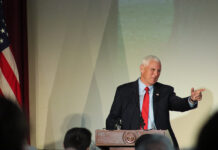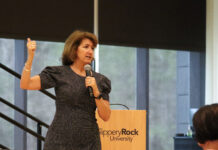Slippery Rock University scored the second highest number of points in academic performance in the state in 2011.
According to Time magazine on Apr. 25, SRU was recognized as one of the top schools who succeeded in performance. SRU earned as much as $1.5 million a year in performance funding.
The Living Learning Community, FYRST seminar, and the Tutoring Center are the most common influential academic programs.
Dr. Mark Campbell, of Trafford, Pa., has a BA in Physics, a BA in secondary education, an MA in guidance, and a doctoral in higher education administration.
A total of 90 to 95 percent of freshmen attend a FYRST seminar class.
“We look at FYRST Seminar as an extension of orientation,” Campbell said. “Freshmen can meet friends in their major and get to know a professor in their department quickly.”
Nearly every major has a FYRST seminar program. This is the first year for safety management and theater to put together a program.
“In academic services, we help students make friendship early on,” Campbell said.
Campbell believes that by grouping students together and sharing enrollment, students can get help with other students in their class.
Almost all of FYRST seminar classes have peer leaders.
“Some messages are hard to get across to students,” Campbell said. “Students will listen to the peer leader better and can listen to his or her experiences. Some students have a high school way of thinking that tutoring is for those who struggle with classes. The peer leader will recommend tutoring and will show students that it can benefit them.”
In FYRST seminar classes, students can learn what their department expects from them.
Campbell will do about 30 one-hour freshmen orientations a semester.
“People who want to get an A in a class are the most popular reasons why they enter the tutoring program,” Campbell said.
He also teaches college workshops and talks about academic services with Carla Hradisky-Coffelt, the director of retention services, 112 North Hall. Hradisky-Coffelt encourages students to come to class to exceed and talks about good decision-making. Campbell’s recommendation is that as soon as a student has questions about a class, he or she should get a tutor.
Students normally get up to two letter grades more than they expected out of the class before getting a tutor. Math and science are the most popular subjects students get tutored for.
The performance funding requirements is competitive. There is a formula the state uses.
“Not many universities have all FYRST seminar programs,” Campbell said. “Students can get to know the professors in their department quickly.”
Campbell used to be a private tutor when he went to college. He tutored statistics and physics. Last time SRU was recognized nationally for their performance in the media was in the Princeton Review in 2003.
“I am thrilled to see SRU in Time magazine,” Campbell said. “The last time we made national media was in the Princeton Review in 2003.”
The highest number of points universities can earn is 14 points. SRU scored 12.5 points. Bloomsburg was the highest in the state at 13 points.
Provost William Williams is excited that SRU was featured in Time magazine.
“The bigger the school, the more money it can get,” Williams said.
There is a long list of how many targets the school has to meet. SRU met 94.9 percent of its targets. Last year, SRU met 39 out of 40 of its baseline evaluation, 15 out 20 in benchmark evaluation, and 39 out of 40 in the summary evaluation.
Williams is creating a new performance plan. The categories are success for students, access to opportunities, and stewardship.
On May 3, the state system, Peter Garland, Lewis Johnson, and George Perell, and Williams talked about the new plan.
“We want to create performance indicators that we can do well in,” Williams said. “The institution wants to help the areas where the institution has the resources.”
SRU is already identified for its traditional-aged resident students, so the administration plans on spending less on commuter benefits. Williams focuses on recruiting students into healthcare and exercise science programs.
Some of SRU’s goals are to increase its faculty production, faculty diversity, terminal degree faculty, retentive rate of first and second year students, and graduation rates.
In 1981, Williams started working at SRU in the English Department. On Jan. 2, 2003, he became provost and is planning to leave his position by the end of the fall semester.







